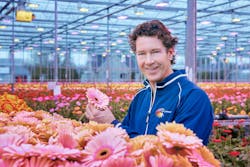A Dutch daisy grower has taken the next step on a multi-year transition to largely LED lighting, replacing half of the high-pressure sodium (HPS) lights in a 1.1-hectare section of its greenhouse with LEDs that provide twice as much light using the same electricity consumption.
Florein Gerbera’s now has hybrid LED/HPS lighting over 60% of its 3.5-ha greenhouse in Naaldwijk, having also switched from HPS to LED/HPS over a 1-ha portion in 2019. In the final stage, it plans to eventually install all LED lighting in the remaining 1.4 hectares.
Florein focuses on the Russian market for the gerbera variety of daisies. It grows 38 different types of gerberas.
In the latest lighting conversion, Dutch installer Stolze Installatie Techniek last October took two weeks to replace half of the HPS lights over the 1.1-ha parcel with Signify’s Philips LED GreenPower toplights, which are designed with connections that facilitate a one-to-one swap. The full name of the product is Philips LED GreenPower toplighting force. Signify introduced it earlier this year, claiming a maximum light output of 3600 μmol/s.
“That is twice as much as an HPS, while using the same amount of energy,” pointed out Reinier Zuidgeest, owner and director of Florein Gerbera’s.
Related article: Learn more about determining horticultural lighting efficacy
Signify rates the toplights with an efficiency of 3.7 μmol/J at full blast, and of 3.9 μmol/J efficiency when dimmed to 50%.
The parties did not reveal how many lights cover the area, or how much money Signify charged the grower. Zuidgeest said that total light level over the 1.1 hectares is now 270 µmol/m2/s, up from 180 µmol/m2/s when the lights were all HPS.
Zuidgeest chose not to install a sophisticated control system. The Signify lights operate at a set blue/red spectrum, optimized for gerberas. They turn on and off in response to human-operated switches, which permit checkerboard lighting patterns on occasions when the grower might want to save more electricity, a Signify spokesperson told LEDs Magazine.
The companies did not reveal a timeline for the conversion of the remaining 1.4 hectares to all LED. That project will include some white light, in addition to the blue/red.
“The energy efficiency will be slightly lower but will still be higher than hybrid lighting,” Zuidgeest said. “You need some white light to assess the flowers, and it is more pleasant for our employees.”
It’s not clear why the same white light logic did not apply to the hybrid 2.1 hectares. LEDs will provide an update if we find out more.
More resources on horticultural SSL
LRC online calculator helps horticultural growers choose luminaires
IES RP-45-21 delivers guidance for horticultural lighting in design terms
Readers find interesting hooks in top horticultural SSL content
MARK HALPER is a contributing editor for LEDs Magazine, and an energy, technology, and business journalist ([email protected]).
For up-to-the-minute LED and SSL updates, why not follow us on Twitter? You’ll find curated content and commentary, as well as information on industry events, webcasts, and surveys on our LinkedIn Company Page and our Facebook page.






